1. The following tutorials are for public network access. The premise is that all operations can be implemented on the intranet. If the intranet cannot be implemented, it can leave messages or Baidu.
2. The following operations are conducted in a specific environment. Due to limited resources, they are not universal but can be adapted to most readers.
3, this article is intended to introduce a working idea, not necessarily limited to the method used in the text, such as the server can also be inserted in the router on the USB device, R7000 router can be replaced with other routers with the same function, the client can use the IOS device Wait.
4, this article also introduced the DDNS and VPN solutions, personally think that VPN security is still higher than the DDNS, because the establishment of the DDNS is equal to the door of your home gateway to the public, access to data will be provided by the domain name The business hand, while the VPN is equivalent to directed direct access routes.
5, exemption, I engaged in the industry has nothing to do with the computer, it is inevitable that there is a place that is not perfect, but to ensure that everything is indisputable, if there is a wrong place, please correct me.
1 Tools 1.1 Server: Win10 OS ComputerIf you need to achieve remote boot function, you need hardware support
1.2 Router: Router with Merlin firmwareThis article uses NETGEAR R7000, which is often used to display Aunt Zhang's home, and version 6.5 firmware.
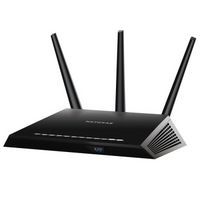 NETGEAR R7000 AC1900M dual-band Gigabit wireless router 799 yuan Aunt Jia Jingdong direct access link View Encyclopedia 1.3 client: win10 operating system computer
NETGEAR R7000 AC1900M dual-band Gigabit wireless router 799 yuan Aunt Jia Jingdong direct access link View Encyclopedia 1.3 client: win10 operating system computer â— The router starts DDNS, maps to the web address aaa.bbb.ccc, authorizes the router to access the network interface, and sets the access port (for example, 1111). It can access the remotely using aaa.bbb.ccc:1111.
â— The VPN is enabled on the router. After the client opens the VPN, it can directly access the router in the form of an intranet (for example, enter 192.168.1.1 in the browser).
Public network remote boot:â— The remote booting needs to be implemented in the router. No matter what method you use to access the router remotely, just turn on the wake-on-LAN function of the computer and you can do it on the router page. The wake-on-LAN function of the computer can be Baidu.
Public network remote login server desktop:After successful remote boot, you can remotely login to the desktop
â— If you do not enable the router VPN function but use the DDNS to access the router, you need to bind the MAC and IP address of the computer that you want to access remotely, and then enable the route port forwarding function to forward one of the router's communication ports (for example, 2222). To the specified IP 3389 port. Then open the remote desktop connection on the client, enter (for example: aaa.bbb.ccc:2222) to start logging in;
â— If you have enabled the VPN function, you can directly open the remote desktop connection on the client, enter the server's computer name, and you can start logging in.
Public network remote access server folder:â— Share the specified folder of the server. Enable the Aicloud function on the router and use the browser to access the client directly. The premise of this method is that DDNS must be turned on;
â— Share the USB device, enable the FTP function on the router, create a new network location on the client, and associate it with the server's FTP folder. The premise of this method is also that DDNS must be turned on;
â— Share the specified folder of the server, enable the router VPN function, create a new network location on the client or map the network drive to the server.
All the functions mentioned in the title 2 are roughly divided into two routes: using the DDNS method and using the VPN method, so the following tutorial is divided into two ways, and the implementation methods of the above functions are separately introduced.
Again, although the use of the DDNS method is easier than the VPN method (VPN involves a login problem, OpenVPN also imports a specific configuration file in a specific login program), but using the VPN method is more secure than using the DDNS method.
3.1 DDNS Method3.1.1 Remote Access to the Router Using the DDNS Method
First you need to have a public IP address, register a domain name with a domain name service provider, and then map the domain name to this public IP address. If you are unlucky, your broadband service provider will not give you a public network IP, but it may also be the purchase of hardware such as peanuts to achieve intranet penetration.
In short, the purpose is to find the address of your home in the huge Internet world. Since the DDNS method can be found everywhere on the Internet, you can use your own Baidu. Here, we only introduce a method of implementing DDNS on the peanut shell website.
a. Open your router and find your public IP
 Router Home
Router Home
b. Open the Peanut Shell website, register an account, and add a shell domain name (free and paid separately). After the completion, you have a domain name of your own aaa.bbb.ccc â–¼
 Peanut shell domain name
Peanut shell domain name
c. Back to the router page, open DDNS, bind the account you just registered, password, domain name (aaa.bbb.ccc) â–¼
 Turn on DDNS
Turn on DDNS
The "Forced refresh interval (in days)" speculation here refers to the number of daily DDNS refreshes, because the broadband network provider will change your public IP address (for example, my home is a change every day), so the router needs constant refresh. , to inform the domain name service provider of your home's latest IP address.
d. At this point, the DDNS mapping has been completed, you can also go back to the peanut shell website to confirm â–¼
 Confirm DDNS
Confirm DDNS
At this time, the router's home page should be like this â–¼
 Router Home - DDNS is set
Router Home - DDNS is set
e. The next step is to open the router's public network access feature â–¼

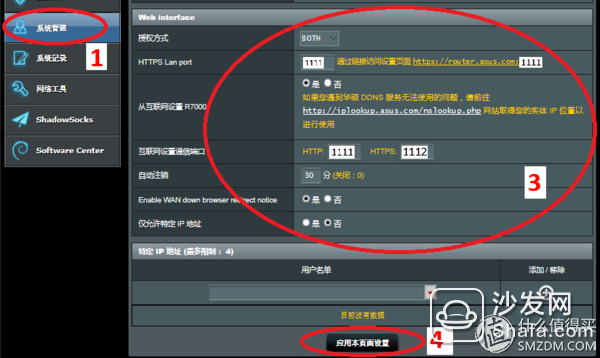 Enable router public network access
Enable router public network access
Authorization: After the delegate, you can access it via http:// or https://, or both.
HTTPS Lan port: Can be set or set
Internet settings communication port: set and keep in mind
f. Here, the "use DDNS method to access the router remotely" is over, according to the above operation, you have the following access addresses:
â— http://aaa.bbb.ccc:1111
â— http://222.222.222.22:1111
â— https://aaa.bbb.ccc:1112
â— https://222.222.222.22:1112
However, since the public network IP has a lease time, it does not make much sense to log in according to the IP address. Today it is 222.222.222.22, and tomorrow it is unknown.
3.1.2 Using the DDNS Method to Remotely Boot the Public Network
The method for remotely booting the public network is the same as the remote booting method for the LAN. The premise is that you need your server hardware support. To put it plainly, the network card and the motherboard support Wake On LAN.
a. boot in your BIOS and network card configuration to open the WOL function, a lot of online tutorials, not described in detail here, paste a URL over everyone to see.
b. Then bind the server MAC in your router access page â–¼
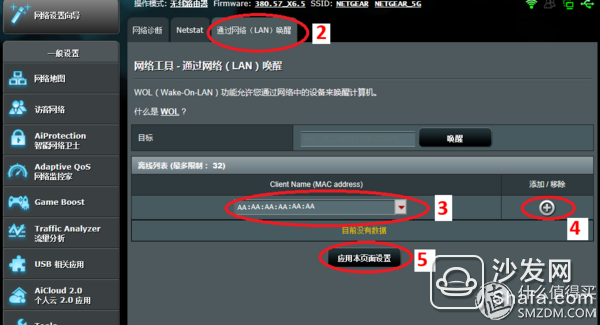
 Bind server MAC
Bind server MAC
c. Once the binding is complete, you can wake it up and your computer will magically shine. â–¼
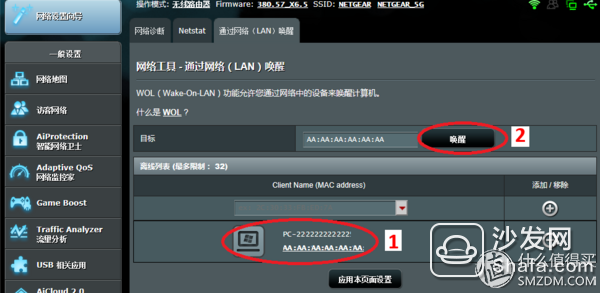 Server wake up
Server wake up
3.1.3 Logging In to the Desktop Remotely Using the DDNS Method
The basic idea of ​​remote login is to access the designated port of the router and map it to the 3389 port of the server to implement the function.
a. The server opens the remote login function, a lot of online, posted here a URL
b. Specify a fixed IP for the server's MAC address

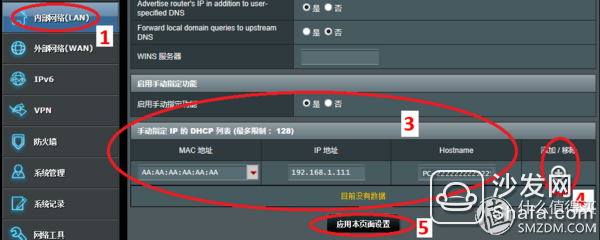 Bind server MAC
Bind server MAC
c. Implement port forwarding on the above IP address â–¼

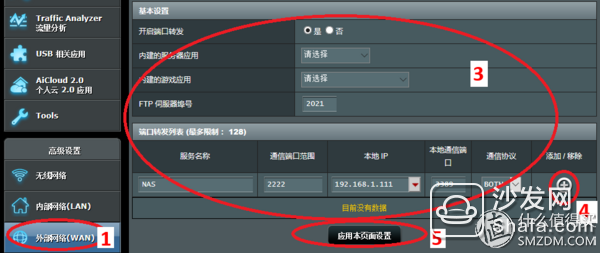 Specify an IP address for the server MAC
Specify an IP address for the server MAC
Service name can be easily filled in, mainly for memory
Communication port range choose a memorable fill
Native IP is the IP address specified in the previous step
The local communication port is 3389
Communication protocol did not understand what is the difference, I use BOTH
d. At this point, the remote login setup is complete. No matter where you are in the world, as long as you can connect to the Internet, use the address aaa.bbb.ccc:2222 to remotely log into your server desktop. â–¼
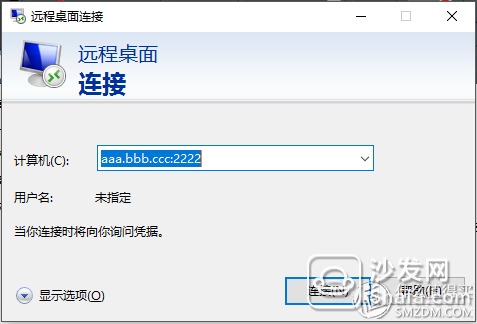 Remote login
Remote login
3.1.4 Using the DDNS Method Public Network Remote Access Server Folder
After the DDNS is defined, there are two methods for remotely accessing the server folder. One is to use the Aicloud function of Merlin firmware to access the private cloud anytime, anywhere, and the other is to establish an FTP folder and access the FTP server remotely.
3.1.4.1 Using Aicloud
a. First, you need to share the specified folder of the server, set the sharing function in the properties of the specified folder, and then start setting up the router â–¼
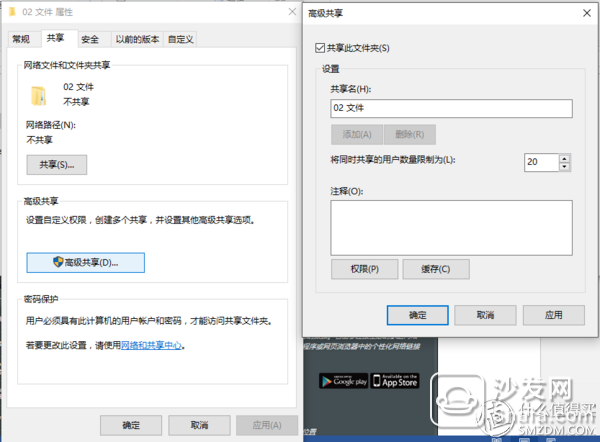 Shared server folder
Shared server folder
b. Access the router page and enable Aicloud functionality â–¼
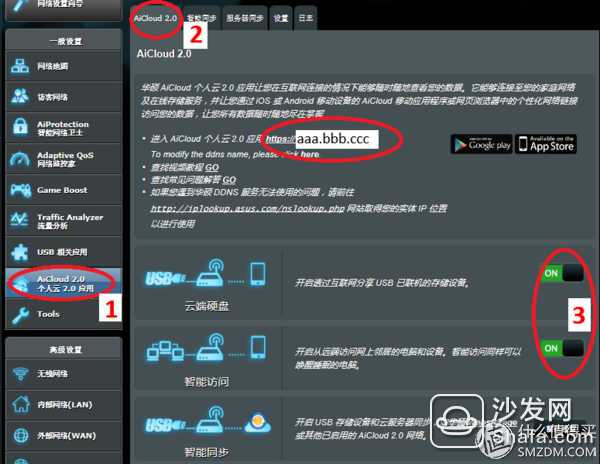 Open Aicloud
Open Aicloud
c. Set password protection for your Aicloud account â–¼
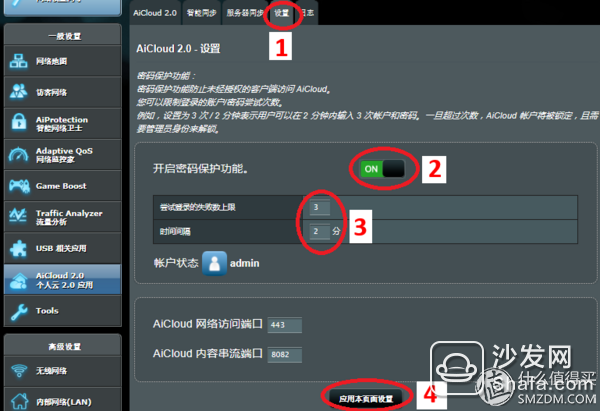 Set Aicloud permissions and password
Set Aicloud permissions and password
d. OK, now you open the public website: https://aaa.bbb.ccc, log in with your router's account password, you can access the shared folders of all servers in the LAN, this way is equivalent to your establishment A private cloud is available anytime, anywhere.
3.1.4.2 Using the FTP Function
In fact, the Merlin firmware's FTP function cannot access server-side shared files and can only access USB devices on the router, but it is also a form of extranet access, so it is described here.
a. Access the router page, open the USB FTP share disk function, you can also add an account, set access permissions for different accounts â–¼
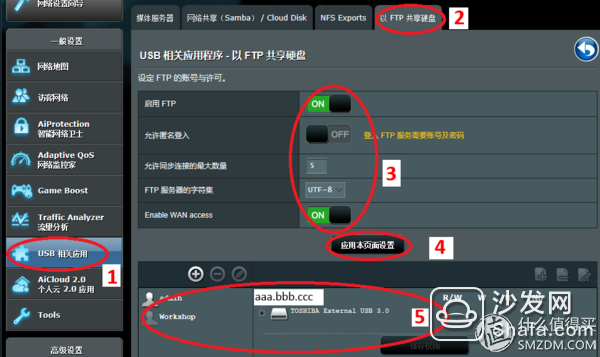 Turn on FTP
Turn on FTP
b. Enter the address ftp://aaa.bbb.ccc in the address bar of any client folder, or create a new network location. Use the account password you set to log in to the FTP server to start browsing the files on the USB device â–¼
 Client establishes FTP folder
Client establishes FTP folder
3.1.5 Summary
When the DDNS method implements functions, it will involve a lot of URLs that need to be remembered.
Use location Address function
Client Browser http://aaa.bbb.ccc:1111 HTTP Mode Remote Login to Router Page
Client Browser http://222.222.222.22:1111 HTTP Mode Remote Login to Router Page
Client Browser https://aaa.bbb.ccc:1112 HTTP Mode Remote Login to Router Page
Client Browser https://222.222.222.22:1112 HTTP Mode Remote Login to Router Page
Client remote desktop aaa.bbb.ccc:2222 remote login server desktop
Client remote desktop 222.222.222.22:2222 Remote login to the server desktop
Client Browser https://aaa.bbb.ccc Remote Access to Aicloud Private Cloud
Client Folder FTP://aaa.bbb.ccc Remote Access Router USB Device
Aunt Zhang does not support the establishment of the table is really forced to die obsessive-compulsive disorder
At this point, the function implementation method of DDNS is introduced. The following describes the VPN function implementation method.
3.2 VPN MethodUsing VPN method operation, the operation of the router is relatively simple, because you do not need to register a domain name to map DDNS, and you do not need to set a lot of URLs and ports to implement the function. The only thing you need to do is to enable the server VPN function. The rest of the work on the side is just like the LAN operation.
3.2.1 Enabling Router VPN
Merlin supports two VPN server modes - OpenVPN and PPTP. The functions that can be achieved by the two methods are the same.
The following describes the OpenVPN mode as an example. According to the Internet, the OpenVPN mode is safer than the PPTP mode, and the PPTP mode is more convenient because the client's win10 system itself supports usernames and passwords to log in to PPTP.
a Router access page, left click on "VPN" â–¼
 Go to VPN Settings Page
Go to VPN Settings Page
b. Open "Turn on Virtual Private Network (VPN) Service" â–¼
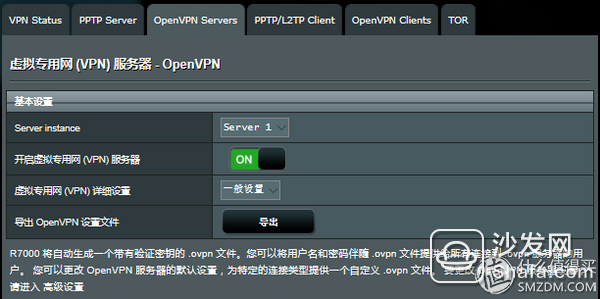 General settings
General settings
c. Select Advanced Settings in the drop-down menu â–¼
 advanced settings
advanced settings
Here is a description of some of the advanced setup parameters to provide non-professionals with only personal experience:
Interface type: When the TUN type is selected, the virtual IP address after the client logs in to the VPN is not in the same network segment as the router, affecting the functions such as the network neighbor.
When the TAP type is selected, the above problems can be avoided;
Username/Password Authentication: If you select Yes, the client will prompt you for the router password every time you log in to the VPN.
Encryption password: If you use the default Default, each time the client logs in to the VPN, it will warn that the password block is too small;
Others I used the default settings and did not try them out.
d. After applying the configuration, return to the General Settings page, export the configuration file, and send the configuration file to your client.
e. Go to the client operation, download the OpenVPN program from the Internet, install it, import the configuration file you just sent, and click Connect. The connection is successful.
3.2.2 Remote Access Router Using VPN Method
In fact, after the client successfully connects to the VPN, it is equivalent to your computer is virtual in your home network, so any operation after this is equivalent to connecting to the LAN in your home.
This is if you want to access your router, just enter the router IP in the client browser (for example: 192.168.1.1).
Well, it's that simple, not even the map.
3.2.3 Using the VPN Method to Open the Server Remotely
This step is the same as remotely opening the server using the DDNS method. See section 3.1.2 on the Internet.
3.2.4 Remotely Logging In to the Desktop Using the VPN Method
Having said that, after the client connects to the VPN, it is equivalent to being in the LAN, so building a remote desktop is very simple:
a. The server opens the remote login function, a lot of online, posted here a URL
b. The client connects to the remote desktop. If necessary, you need to enter the password of the server login account â–¼
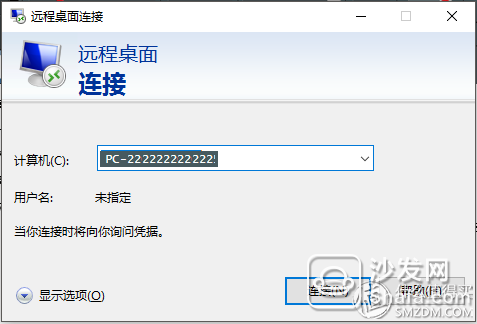 VPN establishes a remote desktop
VPN establishes a remote desktop
c. Get it
3.2.5 Using the VPN Method Public Network Remote Access Server Folder
If you do not set up DDNS, you cannot use Aicloud to access the folder;
If you do not have FTP enabled, you cannot use FTP to access USB devices.
But if you use a VPN, then there is a more convenient way to implement this feature, that is, Network Neighborhood and mapped network drives.
All you need to do is share the folder on the server side â–¼
 Shared server folder
Shared server folder
Then, in the client "My Computer" - "Network" to access the server's shared file, or in the client "My Computer" add "Mapped Network Drive", so that you can access the same as the local file To access the server file.
4 summarize啰啰嗦嗦 Say a lot, compare the advantages and disadvantages of the DDNS method and the VPN method:
DDNS:
advantage:
â— You can use Aicloud Private Cloud to access your private cloud like Baidu Cloud on any computer â—Easy to use, you only need to use the URL to implement each function
Disadvantages:
â— Low security, which is equivalent to opening the door of your home to the world. The key is just a poor user name and password. â— The router setting method is complicated â— You need to memorize a lot of addresses, user names and passwords, and it is better not to put all The username and password are set to be the same, because once the hackers intercepted your information, it will all be unblocked.
VPN:
advantage:
â— High security, only open services to your specific users â— Simple setup, only enable router VPN function â— No large number of addresses, large number of user names and a large number of passwords
â— If your router adds SS, using VPN can also help you access the Internet scientifically.
Disadvantages:
â—OpenVPN can't access anytime, anywhere. If you temporarily use a computer and don't have OpenVPN configuration files on hand, you can't do anything.
Therefore, considering the needs comprehensively, my configuration method is
1, open the router DDNS, open Aicloud, to meet the needs of the occasion
2, remote login router, remote wake-up server, remote login server desktop and remote access server folder using VPN
In this way, this article counts as an introduction to the router, giving everyone a tossing idea and welcomes heroes to guide reviews.
best dc current sensor,best current sensor,ac current sensor,battery current sensor
Shanghai Zhilong Electronic Technology Co.,Ltd , https://www.zhilongsensor.com
